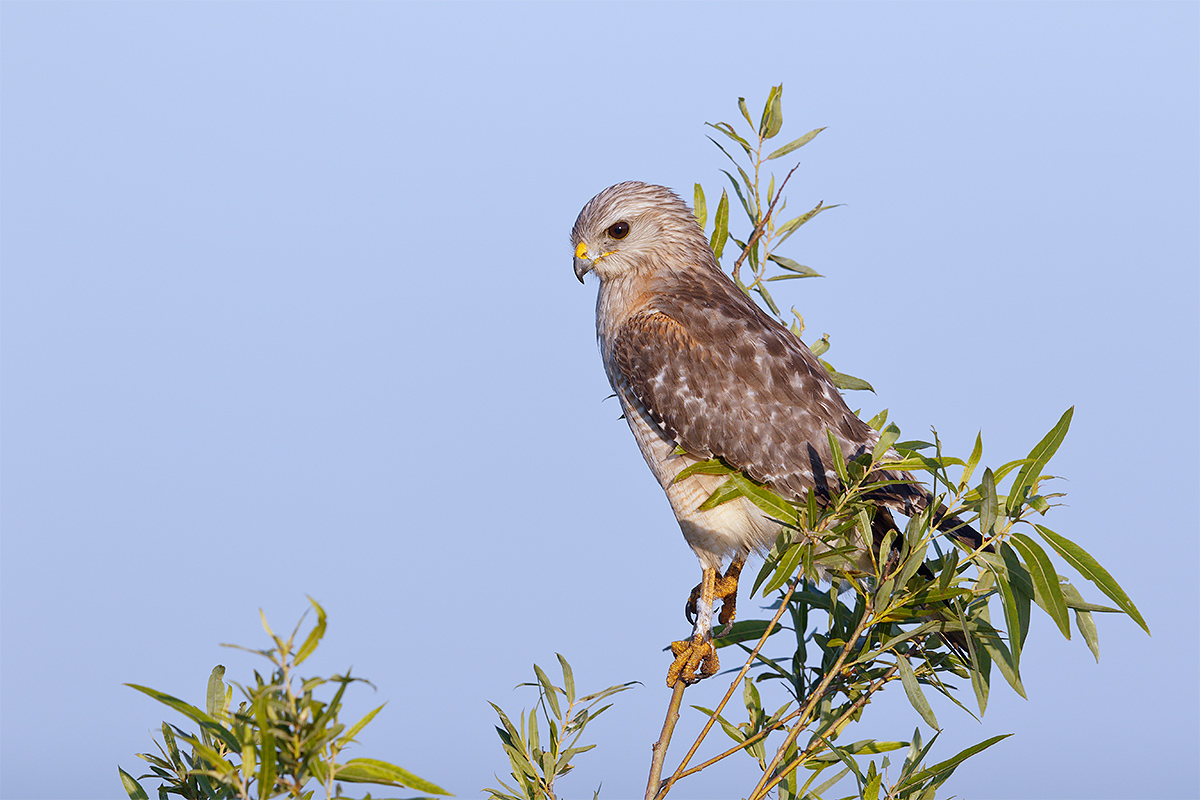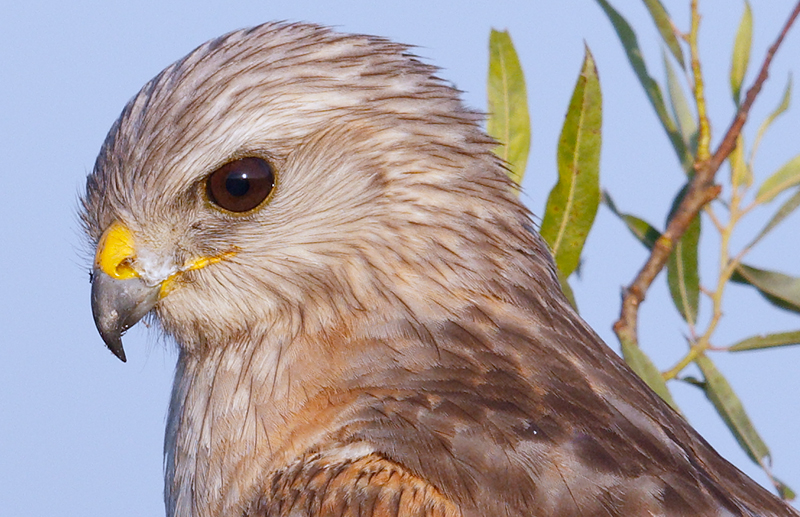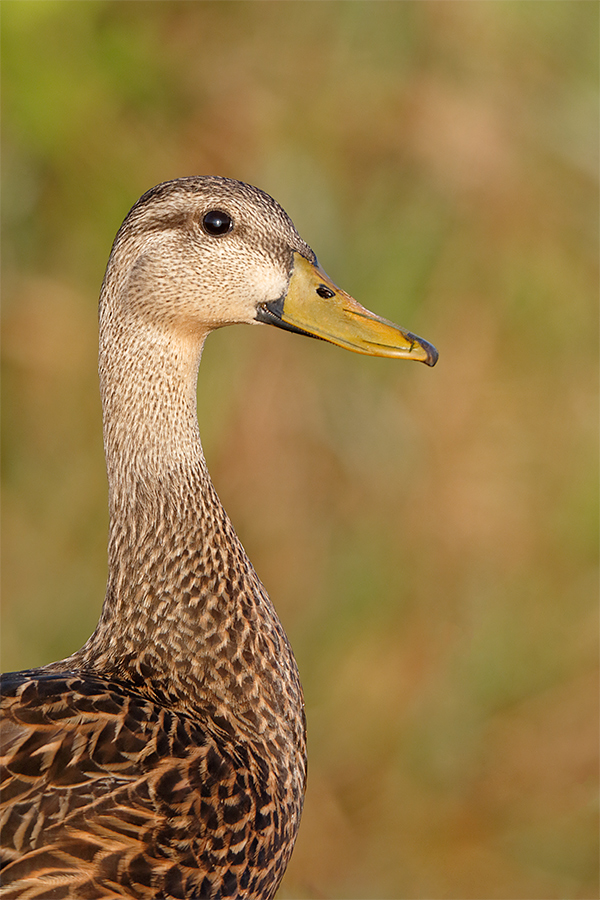What’s Up
Swim and ice bath. Lots of office work. Congrats to Geno Auriemma on his 10th Lady’s NCAA championship. The Lady Huskies could not hit a basket till late in the second half but held off a game Notre Dame team rather easily. This blog post, the 90th in a row, took about 2 hours to prepare; it was published just after midnight early on Wednesday morning.
|
This image was created from my SUV at Indian Lake Estates, FL with BLUBB-supported Canon EF 600mm f/4L IS II USM lens and which camera body? ISO 400. Evaluative metering +1 stop: 1/2000 sec. at f/4.5 in Manual mode. Three AF points up from the center AF point/AI Servo/Rear Focus AF on the bird’s eye and release. Click here to see the latest version of the Rear Focus Tutorial. Click on the image to see a larger version. Image #1: Red-shouldered Hawk |
Down By the Lake
I am gonna make an effort to get the gear in the car and get down to the lake every sunny morning. Right now there are several half-grown Sandhill Crane colts along with a pair of still-small chicks. Along with a very few other photographable species like Red-shouldered Hawk (above) and Mottled Duck (below). Other possibilities include Bald Eagle, Turkey and Black Vultures, Limpkin, and Wild Turkey.
Unsharpened 200% view of hawks head |
Making Sharp Images Off the Blubb
It is best when working off the Blubb to have AF active at the moment of exposure to ensure that your accidentally moving the lens does not throw off accurate focus…. Rotating the lens even a fraction of a single degree will always ruin an image as it will effectively turn the focus ring. In the opening image I framed the image, pressed the rear button to focus, released the rear button, and made the image without moving the lens at all. As you can see in the 200% crop immediately above, careful technique created an extremely sharp image.
With the image below–made with the2X III TC on an f/4 lens–I was working with a minimum effective aperture of f/8 and was thus limited to the center AF point. Note: by pushing the grid button you can add the four expand points. If I had kept AF active at the moment the duck would have been way too far forward in the frame with the bill near or touching the right frame edge. So I took a gamble, rear button focused on the duck’s eye, and re-composed carefully making absolutely sure not to rotate the lens at all as I shifted the lens down and to the right. The proof is in the sharp eye.
|
This image was created from my SUV at Indian Lake Estates, FL with BLUBB-supported Canon EF 600mm f/4L IS II USM lens, the Canon Extender EF 2X III, and which camera body? ISO 400. Evaluative metering -1/3 stop: 1/500 sec. at f/9. Center AF point (by necessity)/AI Servo Expand/Rear Focus AF on the duck’s face and re-compose. Click here to see the latest version of the Rear Focus Tutorial. Click on the image to see a larger version. Image #2: Mottled Duck head and shoulders vertical portrait |
You’re On the Spot: Image Quality/Which Camera Quiz
In the recent blog post here, both John Giatropoulos and Steve Soderling left comments to the effect that they were able to distinguish 1D X and 7D II images based on image quality.
They, and everyone else here, are invited to leave a comment and let us know which of today’s images were created with a 1D X and which were created by a 7D II. And they are of course welcome to let us know why they made their choices.
There will be lots more like this in the coming weeks.
|
All of the images in the bear boat card above were created in Katmai National Park during the month of September. |
Just Two Slots Left!
Bear Boat/Bears Catching Salmon IPT: September 1-8, 2015 from Kodiak, AK/6 FULL & 2 1/2 DAYS: $6699. Happy campers only! Maximum 8/Openings: 2. Plus the leader: Arthur Morris.
This trip is a go.
Join me in Katmai National Park, AK for seven days of photographing Coastal Brown Bears (grizzlies) catching salmon, fattening up for the long winter. Other subjects will include Mew and Glaucous-winged Gulls in flight and dip-feeding on salmon roe. Did I mention that we live on a boat and that the food is great? Most of our photography will be done in a variety of famed locations: Geographic Harbor, Kinak Bay, and Kukak Bay. We once had 39 bears fishing the creek at Kukak….
It is mandatory that you be in Kodiak no later than the late afternoon of August 31, 2015 September to avoid missing the float planes to the boat on the morning of September 1. With air travel in AK being what it is, with the chance of fog or other bad weather–being on Kodiak on August 30 is an even better plan). I will be on Kodiak on August 30 to avoid any potential disaster. That said in my nearly a dozen bear boat trips I was delayed only once but since I was day early as noted above there was no harm, no foul.
We will take one or more float planes to the boat mid-morning on September 1. We will photograph bears fishing that afternoon and every day for the next six days (weather permitting of course). We should have bears catching salmon every day. In addition, we will get some nice stuff on Mew Gull and Glaucous-winged Gulls dining on roe and the remains of predated salmon. We may–depending on where the concentrations of bears are–get to photograph Harbor seals and some hauled out Steller’s Sea Lions (an endangered species). Halibut fishing (license required) is optional. On September 8, our last morning on the boat, those who would like to enjoy one last photo session will do so. The group returns to Kodiak via float plane midday. Most folks will fly to Anchorage and then continue on red-eye flights to their home cities.
The eight days will consist of six full days (Sept 2, 3, 4, 5, 6, & 7) of photography featuring lots of Coastal Brown Bears catching salmon as above plus a variety of other natural history subjects plus some nice scenic photography that I forgot to mention above. Plus the first afternoon and the last morning.
What’s included? 8 DAYS/7 NIGHTS on the boat as above. All meals on the boat. (The food is quite excellent.) National Park fees. One night’s double occupancy lodging on Kodiak; arrive: Sept 1/depart: Sept 2. The thank-you-in-advance dinner on Sept 1. In-the-field photo tips, instruction, and guidance. An insight into the mind of a top professional; I will constantly let you know what I am thinking, what I am doing, and why I am doing it. Small group image review, image sharing, and Photoshop instruction on the boat.
What’s not included: Your round trip airfare to and from Kodiak, AK (almost surely through Anchorage). All necessary lodging other than the cost of your double occupancy room on the night of August 31 should you opt to arrive early–we can arrange that in advance for you. We will let you know the cost of a single supplement for the one night if so desired. The cost of the round-trip float plane to the boat on September 2 and back to Kodiak on September 9. The cost of a round trip this year was $500. The suggested crew tip of $210.
Is this an expensive trip? Yes, of course. But with 6 full and two half days, a wealth of great subjects, and the fact that you will be walking with the bears just yards away (or less….) it will be one of the great natural history experiences of your life. Most folks who take part in a Bear Boat IPT wind up coming back for more.
A $2,000 per person non-refundable deposit by check only made out to “Arthur Morris” is required to hold your spot. Please click here to read our cancellation policy. Then please print, read, and sign the necessary paperwork here and send it to us.
Your deposit is due immediately. That will leave a balance of $4699. The next payment of $2699 will be due on February 15, 2015. The final payment of $2000 is due on May 1, 2015.
I hope that you can join us for this wondrously exciting trip.
Be sure to like and follow BAA on Facebook by clicking on the logo link upper right. Tanks a stack!
Support the BAA Blog. Support the BAA Bulletins: Shop B&H here!
We want and need to keep providing you with the latest free information, photography and Photoshop lessons, and all manner of related information. Show your appreciation by making your purchases immediately after clicking on any of our B&H or Amazon Affiliate links in this blog post. Remember, B&H ain’t just photography!
Amazon.com
Those who prefer to support BAA by shopping with Amazon may use this link:
Amazon Canada
Many kind folks from north of the border, eh, have e-mailed stating that they would love to help us out by using one of our affiliate links but that living in Canada and doing so presents numerous problems. Now, they can help us out by using our Amazon Canada affiliate link by starting their searches by clicking here. Many thanks to those who have written.
Typos
In all blog posts and Bulletins, feel free to e-mail or to leave a comment regarding any typos or errors. Just be right :).


















I would guess that image one was 1DX and image 2 the 7DII. Although I saw something you took on another site that suggests it may be possible to get a pretty darn sharp image with the 7DII.
Actually, I can hardly believe that image 1 is really a 200% crop. I didn’t think it was possible to get a 200% image (which means to me that there are 4 screen pixels for every camera pixel) that looks this sharp!!
And NO! I did not read any of the other posts before I wrote this comment!
Just a guess based on perceived sharpness: Image #1 with 1DX and Image #2 with 7DII. For comparison I’d love to see a 200% unsharpened crop of the duck as well. As usual, thanks for your time and dedication to help us all become better photographers!
Purely a guess … I have a 1dx but no experience with the 7dmII ..
Image #1 – 1DX
Image #2 – 7DMII
I only have personal experience with 7D Mark II so I would only be guessing but I’ll say both pictures are the 7D Mark II (I’m counting on a trick question 🙂 But my real reason for commenting is that I want to know when you are going to reveal the real answer. Soon I hope…
Patience Doug. I have not forgotten this one. a
Of course I cannot tell which camera was used, but then I never have claimed to be able to do that. In terms of pure IQ, the first one is (more?) impressive; wow, 200%. Both are lovely images and ones I’d always be ecstatic to match with any camera.
Honestly, cant really tell… My guess is first image is from 7DMKII and the duck is from 1DX. The 200% hawks head image shows little noise in the brown branches behind the bird’s head made me think like that. I am pretty sure, I am completely wrong 🙂
change of opinion on the 2nd image – i think it too was a 7DII
OK I’ll admit this is tough, but since you have put us on the spot, and I am typing with sweaty palms my guess is tht the top image was taken with the 7DII and the bottom image with the 1DX. As I said in the original post, my successful guessing rate is pretty good but not always. I was wondering if perhaps you post process 1DX and 7DII images in DPP differently? Oh and as for my reasons: as I said in my original post the 1DX images seem to be creamier and smoother – seem to have more shape and “depth”.
I can’t tell. I shoot back and forth between those two bodies all the time now depending on subject distance and light levels. If I shoot the exact same subject with similar framing I can tell as the 1DX has more natural contrast to the images before processing.
My guess is both were 7D2.
Just a guess… First image was taken with the 7dII – based on somewhat more depth of field at f4.5 than you might expect from a FF. Second image from 1DX, again based on depth of field being very shallow even at f9.
I suspect (OK, it’s a guess) the first image was captured with the 7D Mark II and the second with the 1D X. I have a 7D2 and have tried to keep up on best shooting techniques with this body. Consensus points toward using higher shutter speeds so I’m going with the first was taken with the 7D2 at 1/2000th and the second with 1D X at 1/500th. Well done!
Not a meaningful test since images were shot at ISO 400. Pretty much any good dslr will give great images at ISO 400. IDX shines over 7D2 when light gets tough and you have to shoot at high ISOs.
Hi Bill, It is not a test. Some folks said that they can tell 1D X images from 7D II images (by judging image quality…) artie
My point exactly. At ISO 400 image quality should be too close to differentiate the bodies. Now at ISO 3200, image quality will favor 1DX.
My guess is that the first picture has been taken with the 1dx, and the second one with the 7d mark II, since it seems to be slightly less sharp. However, this can be caused also by the extender 2x, that coupled with the lens offers less contrast and resolution, with respect to the combination with 1.4x.
A small remark. In the first picture you say that the aperture is f4.5, but it should be at least f5.6, since you are using the 600 f4 with an extender 1.4x.
The first image says it was shot at f/4.5; however, it was shot with an f/4 lens and a 1.4 Extender. I thought that would result in a minimum f stop of f/5.6?
Can you help out my thinking here?
Thanks!
Thanks Warren. Good catch. I checked and of course learned that the 1.4X was in my pocket. I am correcting it now. a
I really have no clue. However if the female duck (mallard?) was shot with the 7D II, I’m impressed, assuming the first image was shot with a ff camera.
No assuming. The caption says that the duck is a Mottled Duck 🙂 a
I’m with you Doug. Pure guess. Since we have no distance info there is no reference point for subject size in the image….but having said that….
No1 looks a bit like it came from 1Dx and no 2 from 7D. I honestly cannot see any difference in image quality, at least on my iPad.
Cheers
David
I keep going back n forth, back n forth…I can’t tell.
It would only be a guess, but I’d say #1 was the 1DX and
#2 was the 7D Mark II. The guess would be that you wanted
to try the II with a 2x converter.
Doug